
 On our Web site, we won't
attempt to give a complete rundown of the rules. We'll simply offer a
broad description of the game in the hope that it will give an
overall 'taste' of how the game works and fire the reader's curiosity
to try it for themselves. The Evolution Game has been extensively
tested and developed over a period of more than ten years. The
result, we believe, is a game which is attractive to handle,
strikingly original in its appearance and structure, and most
importantly great fun to play.
On our Web site, we won't
attempt to give a complete rundown of the rules. We'll simply offer a
broad description of the game in the hope that it will give an
overall 'taste' of how the game works and fire the reader's curiosity
to try it for themselves. The Evolution Game has been extensively
tested and developed over a period of more than ten years. The
result, we believe, is a game which is attractive to handle,
strikingly original in its appearance and structure, and most
importantly great fun to play.
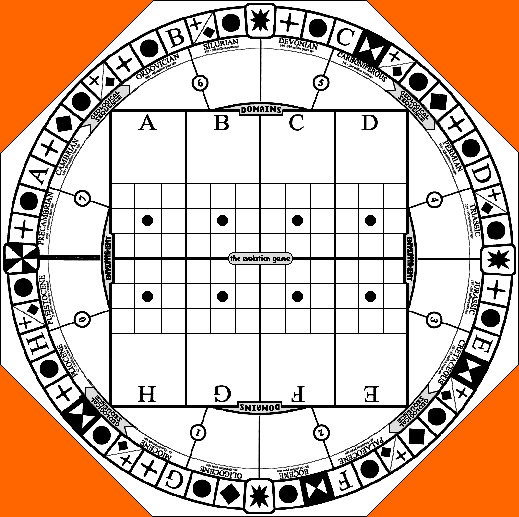 THE GAME
BOARD
consists of three
different areas
1. THE
ENVIRONMENT
THE GAME
BOARD
consists of three
different areas
1. THE
ENVIRONMENT
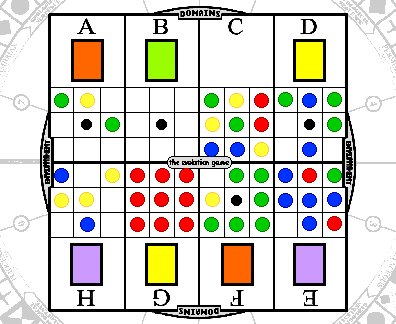 The 'environment' is the central area of the board and
this is where most of the action takes place. Each of the 8 domains
(labelled from A to H) has 9 territory squares and (usually) a
coloured "specialisation" card showing the environmental conditions.
During the game the environmental conditions will be continually
changing. Every player will try to occupy as many territory squares
as possible with colonies of their own species (i.e. coloured
counters). To achieve this, it will often be necessary to compete
with other players' colonies.
2. THE
GEOLOGICAL SEQUENCE
The 'environment' is the central area of the board and
this is where most of the action takes place. Each of the 8 domains
(labelled from A to H) has 9 territory squares and (usually) a
coloured "specialisation" card showing the environmental conditions.
During the game the environmental conditions will be continually
changing. Every player will try to occupy as many territory squares
as possible with colonies of their own species (i.e. coloured
counters). To achieve this, it will often be necessary to compete
with other players' colonies.
2. THE
GEOLOGICAL SEQUENCE
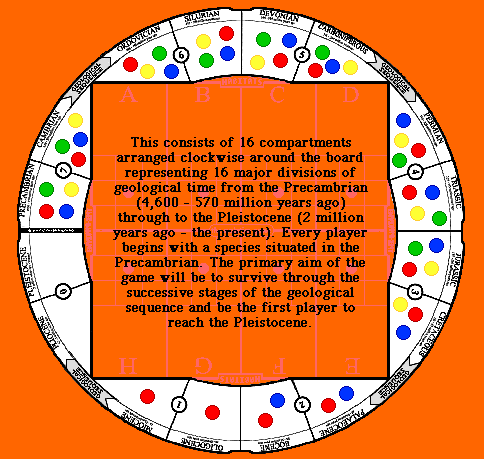 AND
AND
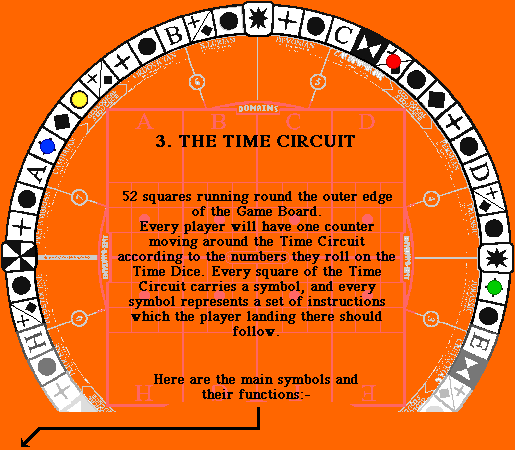

 Mutation: The player
draws some new Mutation cards which may help their species to stay
adapted to the environment.
Mutation: The player
draws some new Mutation cards which may help their species to stay
adapted to the environment.

 Population Growth:
The player gets some new colonies to place into the
environment.
Population Growth:
The player gets some new colonies to place into the
environment.

 Natural Selection:
The player draws a Natural Selection card and follows its
instructions.
Natural Selection:
The player draws a Natural Selection card and follows its
instructions.
 Environmental Change: The Environment Dice is rolled to set a new "colour"
for the indicated domain's environmental conditions.
Environmental Change: The Environment Dice is rolled to set a new "colour"
for the indicated domain's environmental conditions.
 Survival Squares:
The only four places on the Time Circuit where players may use their
ecological niches to survive into the next stage of the geological
sequence.
Survival Squares:
The only four places on the Time Circuit where players may use their
ecological niches to survive into the next stage of the geological
sequence.

 Population Control:
The player rolls the two Population Control dice to discover if they
will suffer losses of colonies from the environment. Some of the
other players may also be affected. The fatal combinations of the
dice are:-
Population Control:
The player rolls the two Population Control dice to discover if they
will suffer losses of colonies from the environment. Some of the
other players may also be affected. The fatal combinations of the
dice are:-
 "disease" : lose 1 colony per
domain.
"disease" : lose 1 colony per
domain.
 "starvation" : lose 2 colonies per
domain.
"starvation" : lose 2 colonies per
domain.
 "global catastrophe" : lose 3 colonies per
domain.
"global catastrophe" : lose 3 colonies per
domain.
 "natural disaster" : empty 1 domain of
all players' colonies.
"natural disaster" : empty 1 domain of
all players' colonies.
GETTING
ADAPTED
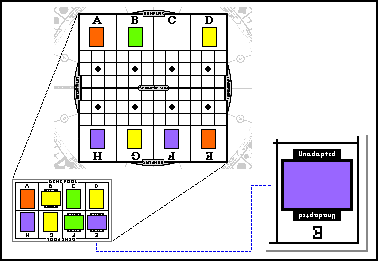 Every player has a gene
pool which indicates the present adaptation of their species to the
environment. If, for example, the A colour in their Gene Pool matches
the A colour in the environment, then their species is adapted to
domain A and the player's colonies may enter and occupy territory
there.
If a player is unadapted
to a domain (e.g. domain E above), the coloured specialisation card
(in the E-compartment of the player's gene pool) is turned sideways
to show the word 'Unadapted' hiding below. The player needs one or
more suitable mutation cards to get adapted. Below you can see
various ways in which a lilac specialisation card can be converted
into an orange one using different combinations of mutation
cards:-
Every player has a gene
pool which indicates the present adaptation of their species to the
environment. If, for example, the A colour in their Gene Pool matches
the A colour in the environment, then their species is adapted to
domain A and the player's colonies may enter and occupy territory
there.
If a player is unadapted
to a domain (e.g. domain E above), the coloured specialisation card
(in the E-compartment of the player's gene pool) is turned sideways
to show the word 'Unadapted' hiding below. The player needs one or
more suitable mutation cards to get adapted. Below you can see
various ways in which a lilac specialisation card can be converted
into an orange one using different combinations of mutation
cards:-
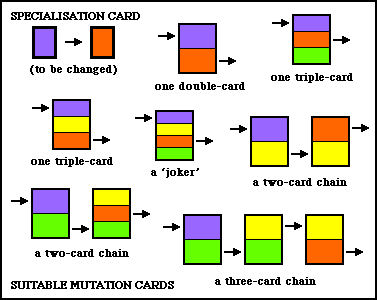 How one or more
mutation cards can be used to adapt
How one or more
mutation cards can be used to adapt
a compartment of your gene pool from one colour to another
colour!
ECOLOGICAL
NICHES
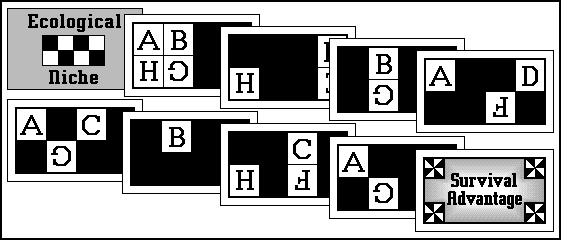 A player's
species is considered to be established in an ecological niche if it
is adapted to every domain shown on the niche card, and has at least
one colony occupying each of those domains. When a player lands on a
survival square
A player's
species is considered to be established in an ecological niche if it
is adapted to every domain shown on the niche card, and has at least
one colony occupying each of those domains. When a player lands on a
survival square
 or
or 
an
established niche allows their species to survive into the next stage
of the geological sequence.
THE
RULES
The
Evolution Game comes equipped with a comprehensive "Rules of Play"
booklet. This presents both the Standard Rules and a more advanced
version which will offer experienced players greater tactical
flexibility and an exciting, challenging end-game. Also included in
the booklet are some useful tips on general strategy and an
informative "Short History of the Earth" outlining the main events in
the life of our biosphere, from the origins of the planet till the
present day. In the game box you will also find a
four-page "Getting Started" leaflet designed to orient and guide complete
beginners, and a "Quick Summary of the Standard Rules" mounted on a
handy laminated card that can be passed around the table for easy
reference.




Also by the inventor of The
Evolution Game:
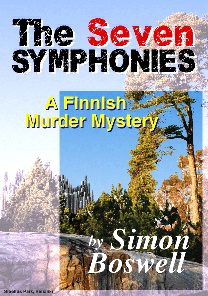
A new full-length crime thriller set in Helsinki with unique
connections to the music of Sibelius..
CLICK ON THE BOOK COVER to visit the website!!
|





![]()
![]() Mutation: The player
draws some new Mutation cards which may help their species to stay
adapted to the environment.
Mutation: The player
draws some new Mutation cards which may help their species to stay
adapted to the environment.![]()
![]() Population Growth:
The player gets some new colonies to place into the
environment.
Population Growth:
The player gets some new colonies to place into the
environment.![]()
![]() Natural Selection:
The player draws a Natural Selection card and follows its
instructions.
Natural Selection:
The player draws a Natural Selection card and follows its
instructions.![]() Environmental Change: The Environment Dice is rolled to set a new "colour"
for the indicated domain's environmental conditions.
Environmental Change: The Environment Dice is rolled to set a new "colour"
for the indicated domain's environmental conditions.
![]() Survival Squares:
The only four places on the Time Circuit where players may use their
ecological niches to survive into the next stage of the geological
sequence.
Survival Squares:
The only four places on the Time Circuit where players may use their
ecological niches to survive into the next stage of the geological
sequence.![]()
![]() Population Control:
The player rolls the two Population Control dice to discover if they
will suffer losses of colonies from the environment. Some of the
other players may also be affected. The fatal combinations of the
dice are:-
Population Control:
The player rolls the two Population Control dice to discover if they
will suffer losses of colonies from the environment. Some of the
other players may also be affected. The fatal combinations of the
dice are:-![]() "disease" : lose 1 colony per
domain.
"disease" : lose 1 colony per
domain.![]() "starvation" : lose 2 colonies per
domain.
"starvation" : lose 2 colonies per
domain.![]() "global catastrophe" : lose 3 colonies per
domain.
"global catastrophe" : lose 3 colonies per
domain. ![]() "natural disaster" : empty 1 domain of
all players' colonies.
"natural disaster" : empty 1 domain of
all players' colonies.


or